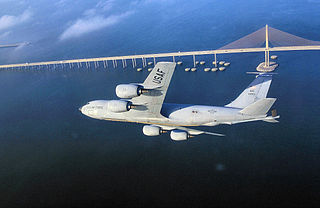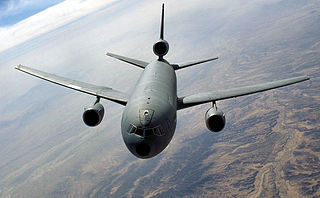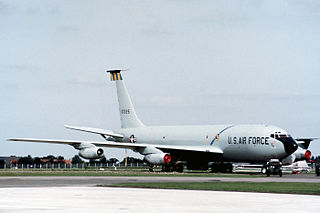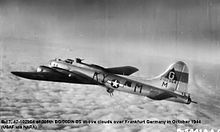
The 32nd Air Refueling Squadron is part of the 305th Air Mobility Wing at Joint Base McGuire-Dix-Lakehurst, New Jersey. It operates the Boeing KC-46A Pegasus aircraft conducting air refueling missions. The squadron is one of the oldest in the United States Air Force, its origins dating to 19 May 1917, being organized at Camp Kelly, Texas. The squadron deployed to England as part of the American Expeditionary Force during World War I. During World War II, the squadron saw combat service as a Boeing B-17 Flying Fortress unit, assigned to the Fifteenth Air Force in Italy. During the early years of the Cold War, it was a Boeing RB-47 Stratojet strategic reconnaissance squadron as part of Strategic Air Command.

The 91st Air Refueling Squadron is part of the 6th Air Mobility Wing at MacDill Air Force Base, Florida. It operates the Boeing KC-135R Stratotanker aircraft conducting air refueling missions.

The 350th Air Refueling Squadron is a United States Air Force unit assigned to the 22nd Air Refueling Wing at McConnell Air Force Base, Kansas. It operates Boeing KC-135 Stratotanker aircraft conducting air refueling missions.

The 305th Operations Group is a United States Air Force unit assigned to the 305th Air Mobility Wing. It is stationed at the McGuire AFB entity of Joint Base McGuire-Dix-Lakehurst, New Jersey.

The 849th Strategic Missile Squadron is an inactive United States Air Force unit. It was last assigned to the 703d Strategic Missile Wing at Lowry Air Force Base, Colorado, where it was inactivated on 1 July 1961 and its assets transferred to another squadron that was simultaneously activated.

The 339th Bombardment Squadron is an inactive United States Air Force unit. It was last assigned to the 96th Bombardment Wing at Dyess Air Force Base, Texas, where it was inactivated on 15 March 1963.

The 423d Bombardment Squadron is an inactive United States Air Force unit. Its last assignment was with the 306th Bombardment Wing at MacDill Air Force Base, Florida.

The 322d Expeditionary Reconnaissance Squadron is a provisional unit of the United States Air Force, assigned to Air Combat Command to activate or inactivate as needed.

The 338th Combat Crew Training Squadron is a currently inactive United States Air Force unit. It was last assigned to the 96th Operations Group at Dyess Air Force Base, Texas, where it was inactivated on October 1, 1993.

The 353d Bombardment Squadron is an inactive United States Air Force unit. It last was assigned to the 301st Bombardment Wing, stationed at Lockbourne Air Force Base, Ohio. It was inactivated on 8 June 1964.

The 352d Bombardment Squadron is an inactive United States Air Force unit. It was last assigned to the 301st Bombardment Wing at Lockbourne Air Force Base, Ohio, where it was inactivated on 8 June 1964.

The 68th Air Refueling Squadron is an inactive United States Air Force unit. It was last assigned to the 305th Bombardment Wing at Bunker Hill Air Force Base, Indiana, where it was inactivated on 25 March 1965.

The 359th Bombardment Squadron was a United States Air Force unit. It was last assigned to the 303d Bombardment Wing, stationed at Davis–Monthan Air Force Base, Arizona. It was inactivated on 15 June 1964.

The 360th Bombardment Squadron is an inactive United States Air Force unit. It last was assigned to the 303d Bombardment Wing, stationed at Davis-Monthan Air Force Base, Arizona. It was inactivated on 15 June 1964.

The 407th Air Refueling Squadron is an inactive United States Air Force unit. It was last assigned to the 42nd Bombardment Wing at Loring Air Force Base, Maine, where it was inactivated on 1 October 1990.

The 336th Bombardment Squadron is an inactive United States Air Force unit. It was last assigned to the 4138th Strategic Wing at Turner Air Force Base, Georgia on 1 February 1963.

The 381st Bombardment Squadron is an inactive United States Air Force unit. It was last assigned to the 310th Bombardment Wing at Schilling Air Force Base, Kansas, where it was inactivated on 25 March 1965.

The 366th Bombardment Squadron is an inactive United States Air Force unit. It was first activated in March 1942. After training with Boeing B-17 Flying Fortress bombers in the United States, the squadron deployed to the European Theater of Operations, where it participated in the strategic bombing campaign against Germany. The squadron was twice awarded the Distinguished Unit Citation for its combat actions. Following V-E Day, it moved to the continent of Europe and engaged in photographic mapping until inactivating in December 1946.

The 365th Bombardment Squadron is an inactive United States Air Force unit. It was first activated in March 1942. After training with Boeing B-17 Flying Fortress bombers in the United States, the squadron deployed to the European Theater of Operations, where it participated in the strategic bombing campaign against Germany. The squadron was twice awarded the Distinguished Unit Citation for its combat actions. Following V-E Day, it moved to the continent of Europe and engaged in photographic mapping until inactivating in December 1946.

The 364th Bombardment Squadron is an inactive United States Air Force unit. Its last assignment was with the 305th Bombardment Wing at Bunker Hill Air Force Base, Indiana, where it was inactivated on 1 January 1970. The squadron was first activated in March 1942. After training in the United States, it moved to England in the fall of 1942, where it participated in the strategic bombing campaign against Germany, earning a Distinguished Unit Citation for its actions. Following V-E Day, the squadron moved to Germany, where it formed part of the occupation forces until inactivating in December 1946.


























